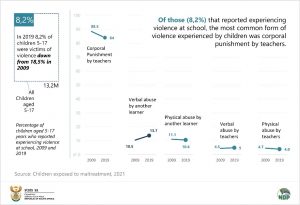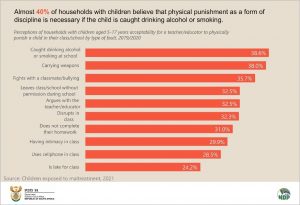Corporal punishment still in schools despite ban
The Abolishing of Corporal Punishment Act, No. 33 of 1997 banned the use of corporal punishment in schools. Despite the ban, corporal punishment is still used as a form of discipline more than 20 years later.
Of those that reported experiencing violence at school, the most common form of violence experienced was corporal punishment by teachers. This is according to a recently released report by Statistics South Africa called Children Series Volume I Children exposed to maltreatment, 2021. In 2019, just over 1 million out of 13 million school-going children aged 5 – 17 years reported that they had experienced some form of violence. Of those who experienced violence at school, close to 84% experienced corporal punishment by teachers, followed by verbal abuse by teachers (13,7%) and physical violence by teachers (10,6%). Between 2009 and 2019, the percentage of children who experienced verbal abuse by other learners increased by six percentage points from 18,1% in 2009 to 24,1% in 2019.
Apart from home, school is the most important place in the lives of most children. Their experience of school will play a vital part in their lives and will determine their academic, social and, probably, their occupational future. However, many children’s experiences of school consist of bullying and abuse from other children.
Violent disciplinary methods were used more on females than males. In 2009, close to 90% of females were subjected to corporal punishment by teachers. By 2019, this figure reduced to 85,5%. Similarly, the percentage of males who experienced corporal punishment reduced to 82,3% in 2019 from 87,3% in 2009.
In 2009, both genders’ experience of physical abuse by teachers were close to 5%. This percentage declined to 3,2% for males in 2019 but remained unchanged for females. On the other hand, more males were victims of verbal abuse by teachers in 2019 (5,6%) compared to females (4,4%). Females also experienced more verbal abuse by peers in 2019 compared to males (14,3% and 13% respectively). However, the reverse was observed with regards to physical abuse by another learner where more males (11,9%) experienced more abuse.
While schools are expected to provide a safe and nurturing environment for children to fully benefit from educational opportunities, teachers and peers are the source of a fearful learning environment in South Africa.
The percentage of children aged 5-17 who reported experiencing some form of violence at school reduced by almost half from 18,5% in 2009 to close to 8,2% in 2019. In 2009 children in rural areas experience violence at school compared to those who lived in urban areas.
Moreover, children in urban areas were three times more likely to experience verbal abuse by other learners compared to their rural counterparts in 2009; and this increased to six times more likely in 2019. Children in rural areas were more likely to be subjected to corporal punishment and other abuses compared to those in urban areas. However, verbal and physical abuses inflicted by other learners were more prominent in urban areas.
In South Africa, close to 2 in 5 households with children believe that physical punishment as a form of discipline is necessary if the child is caught drinking alcohol or smoking. Similarly, two in five (38%) households with children believed that children must be physically punished for carrying weapons at school. Almost 36% of households with children said that they thought it was acceptable for children to be physically punished for fighting with a classmate or for exhibiting bullying behaviours. Furthermore, close to one-third of households revealed that children should be physically punished at school if he/she argues with the teacher, leaves the class or the school without permission during school hours or disrupts the class.
Preventing violence against children requires a major shift in what societies regard as acceptable practices. Corporal punishment and verbal abuse by teachers are socially accepted and not considered as maltreatment of children. In addition, media reporting typically focus on extreme cases that involve deaths or sexual abuse of children. It is nevertheless important to note that the use of violence to punish children may be used with no intention to hurt the child, but this may have negative short term as well as long term consequences. These include physical injuries as well as emotional scars.
For more information download the full report here.



